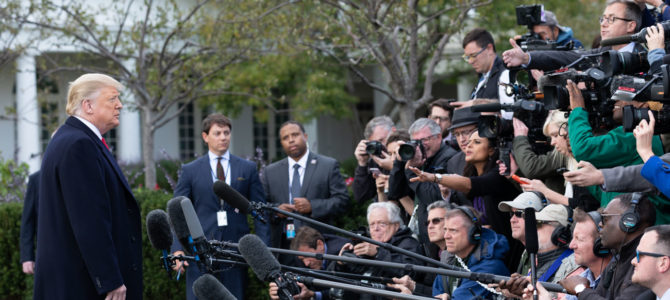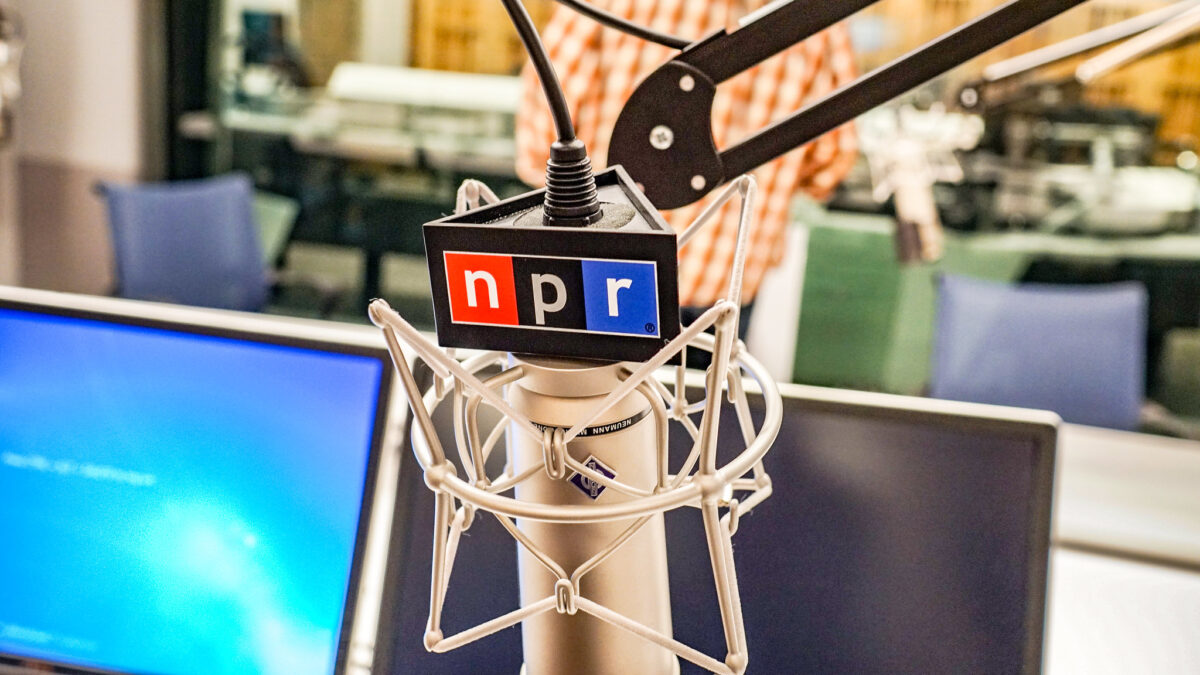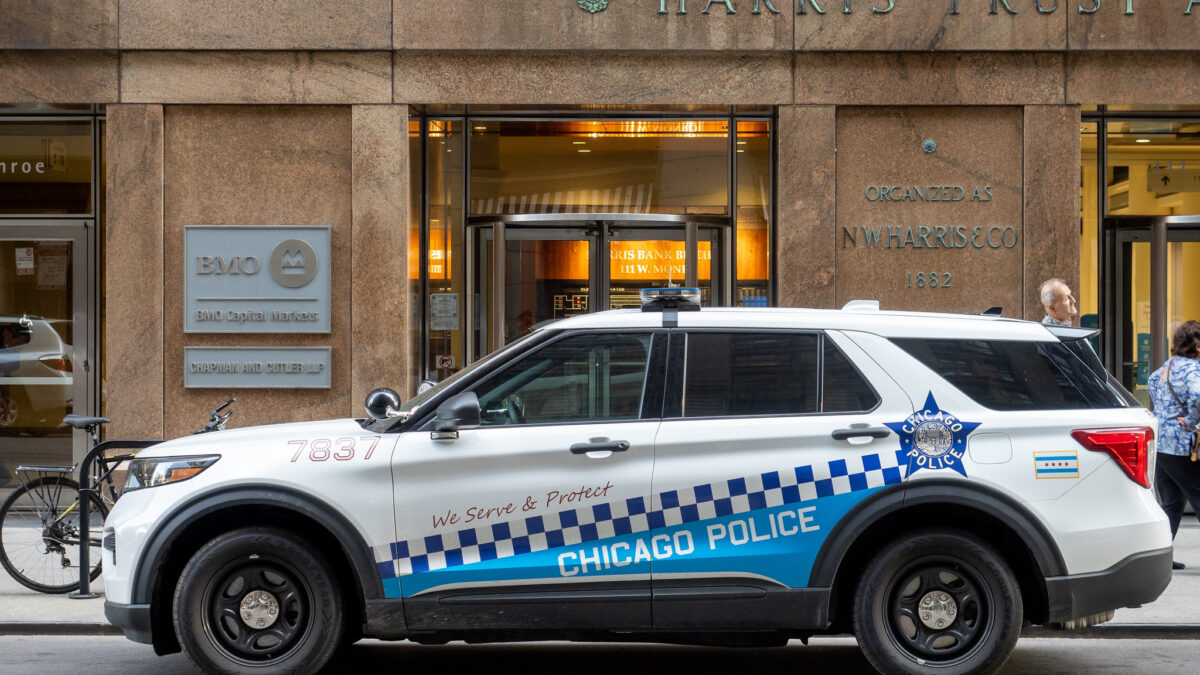
It took more than five years, but the corporate media finally have the tools and strategy to successfully defeat President Donald Trump.
The corporate media have these, mind you, despite the Democratic Party, whose foibles, stumbles, and misfires over those same five years have only complicated efforts, kicking off with a disastrous 2016 defeat and eventually culminating in a near-invisible and increasingly senile presidential candidate stumbling through a script in his basement.
“In the three months [since Joe] Biden launched his stay-at-home campaign from his cellar TV studio, his lead has grown to double-digits in national polls while Trump has pinballed from crisis to crisis,” a June 24 Politico piece notes. In the article, titled “Dems Warm To Biden’s Bunker Strategy,” the candidate’s three months of not holding a press conference is framed as just an attack from the president and his allies, while the facts of that accusation are not challenged.
The article is illuminating not just because reporters ostensibly covering the presidential race are writing like it’s occurring in an fishbowl they and their colleagues don’t largely control, but because the article stands out as one of the very media acknowledgements of this disappearing act in any corporate media outside of Fox News. Even a Saturday Atlantic article on how little voters know about Biden is bereft of a single criticism of the campaign’s active press-exclusion strategy — or of the absence of the vast majority of national political reporters, who appear to not be doing any actual reporting on their candidate.
Similarly, Monday’s New York Times readers had to read 19 paragraphs into a front-page article to learn that the Democrat’s strategy is strongly supported by former President Barack Obama, who “bluntly counseled Mr. Biden to keep his speeches brief, interviews crisp and slash the length of his tweets, the better to make the campaign a referendum on Mr. Trump and the economy, according to Democratic officials.”
It’s not surprising Obama would suggest a strategy the requires a neutered media: He is no stranger to complicit journalists. Before the late-Sen. John McCain and then-Gov. Mitt Romney enjoyed corporate media sainthood for their opposition to Trump, the press hounded them as murderous, delusional, existential threats to the United States.
President Obama, on the other hand, was depicted as a superhero, literal saint and even Hindu god on the covers of magazines. It’s a lesson that stuck with him, and he’d like to use it again.
The New Lines Of Attack
Shielding a candidate from the majority of media criticism can only do so much, and in February as a seemingly assured re-election loomed, corporate media still lacked lines of attack that worked on President Trump. But after flailing through character assassination, press freedom and access meltdowns, Russian collusion, Ukrainian meddling, unceasing accusations of bigotry, and even “the Emoluments Clause,” they finally found them.
A popular D.C. newsletter known for dispensing conventional wisdom crowed the all-star lineup Monday morning, listing a growing number of crises haunting the administration. Among them: state and local governments backtracking on openings; a severely imperiled economy; D.C.’s failure to pass police reform; and Biden’s surging polling amidst Trump’s seeming inability to highlight his contrasts. “Is there one thing,” the letter asks, “going well for President Donald Trump right now?”
While every one of these crises is rooted in real facts and events, would a single one of them be covered this way if Hillary Clinton were the president of the United States?
The Coronavirus
The corporate media spent March, April, May, and June demonizing Republicans and lauding Democrats for their handlings of a disease that killed three times as many people in Gov. Andrew Cuomo’s New York as the recently targeted states of Alabama, Arizona, Arkansas, Florida, North Carolina, South Carolina, Texas and Utah combined.
Since the end of May and through June, corporate media have actively promoted and adoringly lauded giant national public gatherings (and riots) for racial justice, communism, anti-policing, and even black transsexuals, plus multiple packed and politicized funerals. And over the past week, headlines have excitedly blared rising numbers of identified coronavirus cases in Republican states.
The number of deaths correlating to these numbers is curiously absent from any headlines. This isn’t surprising: When corporate media were working to destroy South Dakota Gov. Kristi Noem’s hands-off approach to the virus, the startling number of cases at a pork-processing plant The New York Times dubbed the “Country’s Biggest Coronavirus Hotspot” were touted by the paper and the dozens of brave reporters who rushed to parrot it.
The death count from this apparent death factory eventually clocked in at two, although this didn’t warrant a follow-up from either The Times or its followers — it didn’t fit the narrative. To find this inconvenient fact, readers would have to dig into the kind of local South Dakota reporting that treated their neighbors’ lives and livelihoods as more than just points on a national board.
Information on the apparent youth of a great deal of the recent cases included in the spikes, leaps in medical care for those ill with the virus, and still stable ICU capacities have also escaped recent headlines. Strange.
Along the same narrative, while recently reopened “Churches, beaches and bars” are cited in the second sentence of a Washington Post story on spiking cases in the South, mass media-backed public protests are not mentioned once. Although some corporate publications have at least given protests mention, the focus of the ire has been overwhelmingly the Republican president, governors, and their supporters. No kidding.
The Economy
The same corporate media that hand-selects its virus statistics to batter and frighten Republican politicians routinely plays the fool when discussing the once-historic-and-now-plummeting economy of the United States. After years of striving to deny Republicans credit for an economic boom under their watch, the corporate media and its friends in government now champion the lockdown that dramatically ended the boom.
To resist this lockdown is called selfish at best and murder at worst; to so much as mention the country that unleashed the disease and lied to the world about it for months is labeled xenophobic. For Republicans, the choices presented are economic suicide or certain death, sprinkled with racism.
Democrats like Colorado’s Gov. Jared Polis, on the other hand, are given a pass while following a similar playbook as his GOP colleagues. And all of the sins, yet none of the wins, seem to fall on the president’s head. You don’t say.
Police Reform
While not nearly as effective a bludgeon yet, next up is the defeat of Republican Sen. Tim Scott’s federal police reform after the alleged murder of George Floyd. Corporate media’s audience might recognize Scott as the South Carolina politician routinely characterized as the “GOP’s only black senator,” despite being one of three total. His bill, backed by Minority Leader Kevin McCarthy and the White House, didn’t get a vote — Democrats, you see, said it wasn’t even worth considering.
Indeed, during the Democratic filibuster of the reform bill, Speaker of the House Nancy Pelosi characterized Scott’s attempt as “trying to get away with murder, actually — the murder of George Floyd.” NBC’s Peter Alexander, to his credit, pressed Pelosi for an apology, but was rebuffed and the story went away.
After Democrats’ defeat of the bill and failure to pass their own, President Trump earned himself another re-election loss narrative and Democrats continued their attacks on Republican inaction with nary an ounce of consequence. Surprise, surprise.
Contrasts — And a Surging Biden
Amidst it all — a media-driven panic, a panic-driven economic collapse, and Democrats’ filibuster of the kind of liberal police reform they say they want — former Vice President Joe Biden has skated under the headlines. At 11 p.m. on Monday night, the top “Joe Biden” stories on Google News list his pledge to repeal the Trump tax cuts, the Trump campaign’s flailing “effort to rebrand” him, his rising poll numbers, his potential running mate, and his staff diversity. Results for Trump, predictably, are harsher.
It isn’t entirely corporate media’s fault, despite their best efforts. The coronavirus is real and it is killing people, even if the virus is largely outside of the president’s control and the numbers are selectively highlighted to hurt him; the economy really is in tailspin and presidents historically pay for this, even if the economic shutdowns are both championed and demanded by the media; and Republicans have floundered in the face of rising disorder and downturning public confidence in police, even if the facts supporting “systemic racism” and police “disproportionately” killing unarmed black men are patently false.
The president is isolated by a Republican Party that has been cowed for decades by unending media attacks and, per usual, just want the hard fights to be over. He’s been slow or unable to shift in tone or strategy to meet this head-on alone, and even if he did shift, he wouldn’t get the credit for it. And while base enthusiasm remains strong when measuring the massive amounts of small-dollar donations, the virus’s impacts on his rallies and sobering effect on his TV appearances have severely weakened his ability to define both his campaign and his opponent.
Despite their roots in reality, there is no doubt that these crises — and the White House and Senate’s attempts to tackle them — would be reported differently if Hillary Clinton were president.
The Federalist’s exclusive Friday Oval Office interview revealed a president and West Wing that are happy and optimistic, while realistic about the political danger they face — a stark contrast, publisher Ben Domenech notes in Monday’s Transom newsletter, with his “interviews in the dark days of George W. Bush’s second term.”
“The president clearly believes he is down, and that he has been prevented from using ammunition curtailed by the continued challenge of the virus and without Joe Biden doing things like walking outside and talking for more than 30 minutes,” Domenech writes. “But the president clearly is not of the opinion that Biden’s lead is insurmountable.”
And it isn’t. But a corporate media that have struggled for years to achieve their openly stated goal of defeating the president finally have a working plan. The president and his Republican allies had better get ahead of it, or Democrats will win the Senate –and Joe Biden will be the next president of the United States.








